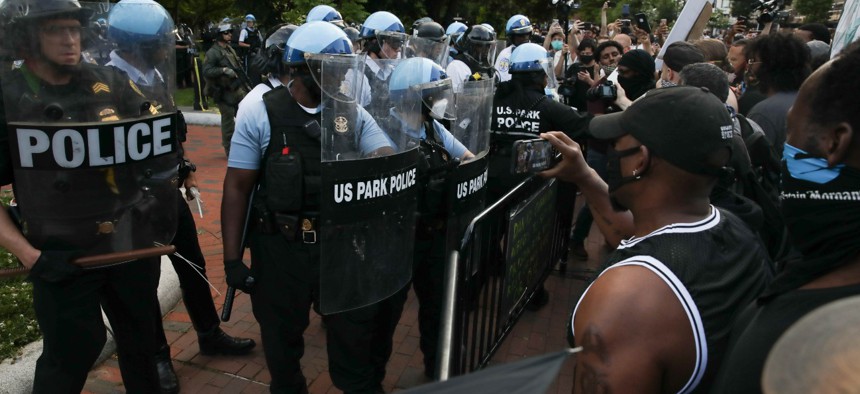The Interior Department Has Released its Body-Camera Policy for Law Enforcement Officers

Demonstrators, gathered at Lafayette Park across from the White House, face a police barricade during a protest over the death of George Floyd, an unarmed Black man who died after being pinned down by a white police officer. Yasin Ozturk/Anadolu Agency via Getty Images file photo
This is part of the department’s actions to implement an executive order from the president to increase police accountability.
Law enforcement personnel at the Interior Department will have to start wearing body cameras.
The announcement was part of a series of actions the department announced on Tuesday to implement President Biden’s executive order to increase law enforcement accountability. All federal law enforcement officers will eventually need to start wearing body cameras under the order, signed on the two-year anniversary of the murder of unarmed Black man George Floyd by a police officer, which sparked nationwide protests for racial justice. Federal law enforcement’s response to the protests in Washington, D.C. was highly scrutinized and criticized.
The Interior Department stated that it added a new chapter to its manual “requiring all Interior law enforcement officers actively patrolling and engaging with the public to carry body-worn cameras; setting the minimum requirements for downloading, documentation and storage of video footage; outlining the intent to expedite public release of video footage by the department following incidents involving serious bodily injury or death; and providing minimum training standards for initial and annual follow-up training consistent with industry standards.”
Interior has law enforcement agents in the Bureau of Indian Affairs; Bureau of Land Management; U.S. Fish and Wildlife Service; and National Park Service, which contains the U.S. Park Police. The Park Police was one of the agencies criticized for its response to the 2020 protests, though the Interior inspector general did clear it of some of the alleged wrongdoing in a report issued in June 2021.
Another new chapter for the manual updates Interior’s policies on the use of force, which builds on a policy the department finalized last year. The department also developed a new no-knock entry policy that includes “restricting no-knock entries to instances where the agent’s announced presence would create an imminent threat of physical violence to the agent and/or another person.” Also, “agents seeking judicial authorization for a no-knock warrant [must] first obtain approval from their first- and second-line supervisor, and an assistant U.S. attorney in the relevant U.S. Attorney’s Office.”
The updates to the manual reflect feedback gathered by a law enforcement task force Interior Secretary Deb Haaland established in July 2021 to build more trust and collaboration between communities and law enforcement. Earlier this year the task force finished 12 listening sessions and received public comments on how to advance its mission. Interior will continue to use public comments to “strengthen and modernize the workforce,” the department stated.
Prior to Biden’s executive order, some federal law enforcement agencies had pilot programs for body cameras. The fiscal 2022 government funding package gave agencies money to further develop them, as Government Executive previously reported.
The executive order says that “as soon as practicable, but no later than 90 days from the date of this order, the heads of federal [law enforcement agencies] shall ensure that their respective agencies issue policies with requirements that are equivalent to, or exceed, the requirements of the policy issued by the DOJ on June 7, 2021, requiring the heads of certain DOJ law enforcement components to develop policies regarding the use of [body-worn camera] recording equipment.”
Government Executive asked the White House and Federal Law Enforcement Officers Association, which the White House coordinated with to draft the executive order, for comment on the agencies’ overall progress.
The White House did not respond for comment. FLEOA was not able to comment on the new policy or agencies’ progress at this time, but flagged related congressional testimony from FLEOA President Larry Cosme in September 2020.
Separate from the executive order, as part of a settlement agreement on four cases, both the U.S. Park Police and Secret Service said in April that they would update their polices for responding to demonstrations, such as by issuing new guidance on the use of non-lethal force and making badges visible. The lawsuits were in response to the agencies’ actions in Lafayette Park in June 2020 during the protests following Floyd’s death.
NEXT STORY: National Archives plans CX research






